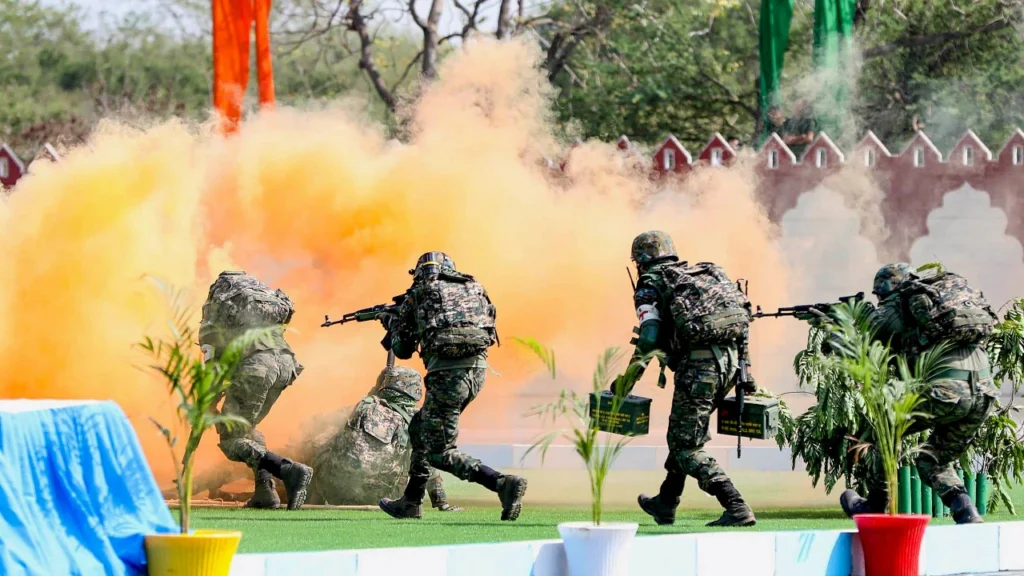Key Takeaways
- India to conduct nationwide mock drills on May 7 as part of Civil Defence preparedness amid growing India-Pakistan tensions.
- The drills will simulate air raids, blackouts, and evacuations across 244 high-risk districts.
- Triggered by the recent Pahalgam terror attack, the government aims to test civilian and military coordination.
- Citizens, students, and local authorities will undergo hands-on training for hostile scenarios.
- These exercises follow high-level security meetings led by Prime Minister Modi.
India to Conduct Nationwide Mock Drills on May 7 Amid Rising India-Pakistan Tensions
As geopolitical tensions with Pakistan intensify, the Indian government is ramping up its readiness with large-scale Civil Defence mock drills scheduled for May 7, 2025. These drills, to be held across 244 categorised Civil Defence districts, come in the wake of the deadly terror attack in Pahalgam, Jammu & Kashmir, which left 26 people, mostly tourists, dead.
The Ministry of Home Affairs (MHA) has unveiled a big readiness initiative that goes beyond mere symbolism. It marks a significant move to assess India’s readiness in the face of modern hybrid warfare and sudden aerial threats.
New and complicated problems have surfaced in the current geopolitical environment. The official MHA instruction sent to all state and Union Territory Chief Secretaries stated that maintaining the highest level of civil defense readiness is essential.
What’s Happening on May 7? A Country-Wide Readiness Check
On May 7, selected districts across India will experience controlled simulations that test everything from air raid sirens to blackout protocols. These aren’t just routine drills—they’re war-readiness exercises aimed at civilian and administrative systems alike.
Key components of the mock drills include:
- Air raid siren testing to simulate aerial attack alerts.
- For real-time coordination, a hotline and communication link with the Indian Air Force have been activated.
- Blackout drills to practice shutting down visible light in urban zones to evade enemy detection.
- Camouflaging vital installations to prepare against aerial reconnaissance.
- Evacuation rehearsals, including safe relocation strategies for densely populated areas.
- Training civilians and students on basic survival and protection techniques.
- Activating Civil Defence Services, including fire, rescue, and depot teams.
These measures serve a dual purpose: enhancing national readiness while also educating the public on what to do in the event of a real attack.
Why Now? The Pahalgam Attack and Rising Hostilities
The urgency of these drills stems from the April 22 terror strike in Baisaran Valley, Pahalgam, which killed 26 people and shocked the nation. The attack, allegedly backed by Pakistan-based extremist groups, has reignited fears of cross-border escalations.
In response, Prime Minister Narendra Modi convened high-level meetings with security and defence officials, including Defence Secretary Rajesh Kumar Singh, to evaluate India’s strategic posture.
Sources confirm that these drills are a direct outcome of those deliberations, as the government looks to send a clear message: India is alert, prepared, and resilient.
Preparing the Nation: How This Impacts You

For most citizens, the drills will be an unusual sight—sirens, blackout orders, and emergency responders in full gear. But beneath the surface lies a deeper goal: building a culture of readiness in an increasingly unpredictable world.
India has historically relied on its armed forces for security. However, modern conflict demands a whole-of-nation approach, where civilians are not just passive bystanders but active participants in resilience.
“Reacting to a catastrophe won’t prepare you for it. “You must practice, plan, and adjust,” advised Dr. Rajiv Bhatia, a strategic affairs specialist and former Indian ambassador.
Civil Defence in the Age of Hybrid Threats
The drills also serve a strategic function in today’s digital and psychological warfare landscape. As nations face threats that go beyond traditional warfare—cyberattacks, drone surveillance, disinformation—Civil Defence is evolving into a multifaceted framework.
From fake news spreading panic to drones breaching airspace, India’s readiness strategy must account for diverse, unconventional threats.
By integrating local administrations, students, healthcare workers, and emergency responders, the May 7 exercises mark a shift from siloed defence mechanisms to holistic national security planning.
What You Should Do on May 7
If you live in one of the 244 categorised districts, here’s what you need to know:
- Stay informed: Local authorities will release specific timings and instructions.
- Follow protocols: Participate in evacuation or shelter-in-place drills seriously.
- Spread awareness: It can be achieved by telling friends, family, and neighbors accurate information.
- Don’t panic: These drills are designed for preparedness, not alarm.
You can find a list of the districts involved on your state disaster management website or follow updates through official government social media handles.
The Bigger Picture: Lessons in Resilience
Beyond testing sirens and simulations, this exercise sends a broader message—that national security begins at the grassroots. In a democracy, resilience isn’t just the job of armed forces or intelligence agencies. It’s everyone’s responsibility.
Whether you’re a student, shopkeeper, bureaucrat, or homemaker, these drills highlight the importance of being informed, proactive, and united in the face of threats.
Conclusion
The mock drills scheduled for May 7 aren’t just bureaucratic exercises. They’re a clear signal that India is not only aware of the dangers looming across its borders but is also taking proactive steps to counter them. From the aftermath of Pahalgam to the corridors of power in Delhi, a powerful lesson echoes preparedness is the best deterrent. When citizens and systems are trained to act, India becomes more than just a target—it becomes a fortress.


